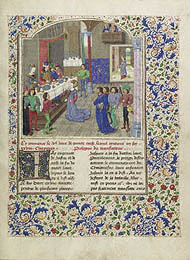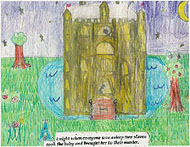Grades/Level: Upper Elementary (3–5)
Subjects: Visual Arts, English–Language Arts
Time Required: Long–Term Unit
Four to six class periods in addition to a fairy tale unit
Author: Danielle Ponder Altemus and Jean Vegas, 3rd Grade Teachers, Marquez Charter Elementary School, Los Angeles Unified School District
Permissions: 
The lesson plan and downloadable materials on this page are licensed under a Creative Commons Attribution 4.0 International License. |
 |
|
 |
Students should be able to:
• explain styles and techniques of illuminated manuscripts.
• create a personal nameplate using a decorated or historiated initial, a border, and illuminations.
• write, illustrate, and illuminate an original fairy tale book. |
 |
 |
• Internet access
• 5-x-7-inch index cards, colored pencils (including gold and silver)
• paper for fairy tale (or explore other materials and binding options)
• various fairy tales that include decorated initials as part of illustrations and writing
• Masterpieces of the J. Paul Getty Museum: Illuminated Manuscripts. Available at the Getty bookstore online.
• Marguerite Makes a Book by Bruce Robertson, illustrated by Kathryn Hewitt. Available at the Getty bookstore online.
• Browse the Manuscripts collection. Look for images that are non-religious in subject matter and include a border, miniature, and possibly a decorated initial. |
 |
 |
 |
1. Show samples of illuminated manuscripts from the Getty collection and list common characteristics.
2. Identify terms, such as decorated initials (letters made from designs without animals), historiated initials (letters made using designs with identifiable figures or narrative scenes), borders, illuminations, parchment, and scribe.
3. Read Marguerite Makes a Book aloud and discuss the process of making manuscripts.
4. View video clip of the process of making manuscripts from the Getty Web site.
5. Explain the importance of decorated and historiated initials and borders.
6. Students use a 5-x-7-inch card and colored pencils to write their first names in the style of illuminations.
7. Students include a decorated or historiated initial and a decorated or historiated border on these cards.
8. Teach fairy tales as unit, reading them while emphasizing important elements of a fairy tale.
9. Through a writing process (prewriting/brainstorming, drafting, revising, editing, and publishing), students will write an original fairy tale including the following elements: repetition of three or seven (7 dwarfs, 3 bears, 3 sons, 3 attempts, etc.), royalty, magic, fantasy creatures, "Once upon a time/happily ever after," hero, villain, etc.
10. Students write or type a final draft of their fairy tale and then illustrate it using the style of illuminated manuscripts.
11. Each page should include at least one decorated or historiated initial and decorated or historiated borders.
12. You may choose to have an activity to bind the stories into a real book format, or bind the class' stories into a single book yourself. |
 |
 |
 |
| Alexander and the Niece of Artaxerxes III, attributed to the Master of the Jardin de vertueuse consolation, about 1468 - 1475 |
 |
|
 |
Visual Arts Standards for California Public Schools
Grade 3
Creative Expression
2.4 Create a work of art based on the observation of objects and scenes in daily life, emphasizing value changes.
Connections, Relationships, Applications
5.2 Write a poem or story inspired by their own works of art.
5.4 Describe how artists (e.g., architects, book illustrators, muralists, industrial designers) have affected people's lives.
Language Arts Standards for California Public Schools
Grade 3
Reading: Literary Response and Analysis
3.2 Comprehend basic plots of classic fairy tales, myths, folktales, legends, and fables from around the world.
3.3 Determine what characters are like by what they say or do and by how the author or illustrator portrays them.
Writing Strategies
1.1 Create a single paragraph:
a. Develop a topic sentence.
b. Include simple supporting facts and details.
1.4 Revise drafts to improve the coherence and logical progression of ideas by using an established rubric.
Writing Applications (Genres and Their Characteristics)
2.1 Write narratives:
a. Provide a context within which an action takes place.
b. Include well-chosen details to develop the plot.
c. Provide insight into why the selected incident is memorable. |
 |
|
 |






